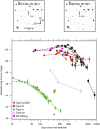A radio-detected type Ia supernova with helium-rich circumstellar material
- PMID: 37198310
- PMCID: PMC10191849
- DOI: 10.1038/s41586-023-05916-w
A radio-detected type Ia supernova with helium-rich circumstellar material
Abstract
Type Ia supernovae (SNe Ia) are thermonuclear explosions of degenerate white dwarf stars destabilized by mass accretion from a companion star1, but the nature of their progenitors remains poorly understood. A way to discriminate between progenitor systems is through radio observations; a non-degenerate companion star is expected to lose material through winds2 or binary interaction3 before explosion, and the supernova ejecta crashing into this nearby circumstellar material should result in radio synchrotron emission. However, despite extensive efforts, no type Ia supernova (SN Ia) has ever been detected at radio wavelengths, which suggests a clean environment and a companion star that is itself a degenerate white dwarf star4,5. Here we report on the study of SN 2020eyj, a SN Ia showing helium-rich circumstellar material, as demonstrated by its spectral features, infrared emission and, for the first time in a SN Ia to our knowledge, a radio counterpart. On the basis of our modelling, we conclude that the circumstellar material probably originates from a single-degenerate binary system in which a white dwarf accretes material from a helium donor star, an often proposed formation channel for SNe Ia (refs. 6,7). We describe how comprehensive radio follow-up of SN 2020eyj-like SNe Ia can improve the constraints on their progenitor systems.
© 2023. The Author(s).
Conflict of interest statement
The authors declare no competing interests.
Figures










References
-
- Whelan, J. & Iben, I.Jr Binaries and supernovae of Type I. Astrophys. J.186, 1007–1014 (1973).
-
- Seaquist, E. R. & Taylor, A. R. The collective radio properties of symbiotic stars. Astrophys. J.349, 313–327 (1990).
-
- Hachisu, I., Kato, M. & Nomoto, K. A new model for progenitor systems of Type Ia supernovae. Astrophys. J. Lett.470, L97 (1996).
-
- Horesh, A. et al. Early radio and X-ray observations of the youngest nearby Type Ia supernova PTF 11kly (SN 2011fe). Astrophys. J.746, 21 (2012).
-
- Pérez-Torres, M. A. et al. Constraints on the progenitor system and the environs of SN 2014J from deep radio observations. Astrophys. J.792, 38 (2014).
Publication types
LinkOut - more resources
Full Text Sources

